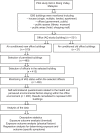Gender, airborne chemical monitoring, and physical work environment are related to indoor air symptoms among nonindustrial workers in the Klang Valley, Malaysia
- PMID: 23526736
- PMCID: PMC3596155
- DOI: 10.2147/TCRM.S39136
Gender, airborne chemical monitoring, and physical work environment are related to indoor air symptoms among nonindustrial workers in the Klang Valley, Malaysia
Abstract
Objectives: The purpose of this study was to analyze the relationship of airborne chemicals and the physical work environment risk element on the indoor air symptoms of nonindustrial workers.
Design: A cross-sectional study consisting of 200 office workers. A random selection of 200 buildings was analyzed for exposure and indoor air symptoms based on a pilot study in the Klang Valley, Malaysia.
Methods: A set of modified published questionnaires by the Department of Occupational Safety and Health (DOSH), Malaysia and a previous study (MM040NA questionnaire) pertaining to indoor air symptoms was used in the evaluation process of the indoor air symptoms. Statistical analyses involving logistic regression and linear regression were used to determine the relationship between exposure and indoor air symptoms for use in the development of an indoor risk matrix.
Results: The results indicate that some indoor air pollutants (carbon monoxide, formaldehyde, total volatile organic compound, and dust) are related to indoor air symptoms of men and women. Temperature and relative humidity showed a positive association with complaints related to the perceived indoor environmental condition (drafts and inconsistency of temperature). Men predominantly reported general symptoms when stratification of gender involved exposure to formaldehyde. Women reported high levels of complaints related to mucosal and general symptoms from exposure to the dust level indoors.
Conclusion: Exposure to pollutants (total volatile organic compounds, carbon monoxide, and formaldehyde) and physical stressors (air temperature and relative humidity) influence reported symptoms of office workers. These parameters should be focused upon and graded as one of the important elements in the grading procedure when qualitatively evaluating the indoor environment.
Keywords: allergy; asthma; environmental climate factor; occupational exposure; regression analysis; sick building syndrome (SBS).
Figures
Similar articles
-
Symptoms prevalence among office workers of a sealed versus a non-sealed building: associations to indoor air quality.Environ Int. 2009 Nov;35(8):1136-41. doi: 10.1016/j.envint.2009.07.005. Epub 2009 Aug 8. Environ Int. 2009. PMID: 19665795
-
Sick building syndrome (SBS) among office workers in a Malaysian university--Associations with atopy, fractional exhaled nitric oxide (FeNO) and the office environment.Sci Total Environ. 2015 Dec 1;536:353-361. doi: 10.1016/j.scitotenv.2015.06.137. Epub 2015 Jul 28. Sci Total Environ. 2015. PMID: 26225741
-
Airborne concentrations of volatile organic compounds, formaldehyde and ammonia in Finnish office buildings with suspected indoor air problems.J Occup Environ Hyg. 2009 Mar;6(3):200-9. doi: 10.1080/15459620802707835. J Occup Environ Hyg. 2009. PMID: 19152165
-
Summary of human responses to ventilation.Indoor Air. 2004;14 Suppl 7:102-18. doi: 10.1111/j.1600-0668.2004.00279.x. Indoor Air. 2004. PMID: 15330778 Review.
-
Sick building syndrome: acute illness among office workers--the role of building ventilation, airborne contaminants and work stress.Allergy Proc. 1990 May-Jun;11(3):109-16. doi: 10.2500/108854190778880268. Allergy Proc. 1990. PMID: 2196201 Review.
Cited by
-
A longitudinal study of sick building syndrome (SBS) among pupils in relation to SO2, NO2, O3 and PM10 in schools in China.PLoS One. 2014 Nov 14;9(11):e112933. doi: 10.1371/journal.pone.0112933. eCollection 2014. PLoS One. 2014. PMID: 25398002 Free PMC article.
-
Working Conditions and Sick Building Syndrome among Health Care Workers in Vietnam.Int J Environ Res Public Health. 2020 May 21;17(10):3635. doi: 10.3390/ijerph17103635. Int J Environ Res Public Health. 2020. PMID: 32455776 Free PMC article.
References
-
- Department of Occupational Safety and Health, Malaysia . Industry Code of Practice on Indoor Air Quality. Putrajaya: Ministry of Human Resources; 2010.
-
- Department of Occupational Safety and Health, Malaysia . Code of Practice on Indoor Air Quality. Putrajaya: Ministry of Human Resources; 2005.
-
- Syazwan AI, Juliana J, Norhafizalina O, Azman ZA, Kamaruzaman J. Indoor air quality and sick building syndrome in Malaysian buildings. Glob J Health Sci. 2009;1(2):126–135.
LinkOut - more resources
Full Text Sources
Other Literature Sources


